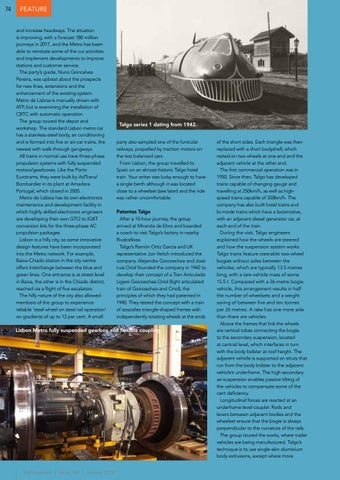74
FEATURE and increase headways. The situation is improving, with a forecast 180 million journeys in 2017, and the Metro has been able to reinstate some of the cut activities and implement developments to improve stations and customer service. The party’s guide, Nuno Goncalves Pereira, was upbeat about the prospects for new lines, extensions and the enhancement of the existing system. Metro de Lisboa is manually driven with ATP, but is examining the installation of CBTC with automatic operation. The group toured the depot and workshop. The standard Lisbon metro car has a stainless-steel body, air conditioning and is formed into five or six-car trains, the newest with walk-through gangways. All trains in normal use have three-phase propulsion systems with fully suspended motors/gearboxes. Like the Porto Eurotrams, they were built by AdTranz/ Bombardier in its plant at Amadora Portugal, which closed in 2005. Metro do Lisboa has its own electronics maintenance and development facility in which highly skilled electronics engineers are developing their own GTO to IGBT conversion kits for the three-phase AC propulsion packages. Lisbon is a hilly city, so some innovative design features have been incorporated into the Metro network. For example, Baixa-Chiado station in the city centre offers interchange between the blue and green lines. One entrance is at street level in Baixa, the other is in the Chiado district, reached via a flight of five escalators. The hilly nature of the city also allowed members of the group to experience reliable ‘steel wheel on steel rail operation’ on gradients of up to 12 per cent. A small
Talgo series 1 dating from 1942. party also sampled one of the funicular railways, propelled by traction motors on the two balanced cars. From Lisbon, the group travelled to Spain on an almost-historic Talgo hotel train. Your writer was lucky enough to have a single berth although it was located close to a wheelset (see later) and the ride was rather uncomfortable.
Patentes Talgo After a 10-hour journey, the group arrived at Miranda de Ebro and boarded a coach to visit Talgo’s factory in nearby Rivabellosa. Talgo’s Ramón Ortiz García and UK representative Jon Veitch introduced the company. Alejandro Goicoechea and José Luis Oriol founded the company in 1942 to develop their concept of a Tren Articulado Ligero Goicoechea Oriol (light articulated train of Goicoechea and Oriol), the principles of which they had patented in 1940. They tested the concept with a train of isosceles-triangle-shaped frames with independently rotating wheels at the ends
Lisbon Metro fully suspended gearbox and flexible coupling.
Rail Engineer | Issue 159 | January 2018
of the short sides. Each triangle was then replaced with a short bodyshell, which rested on two wheels at one end and the adjacent vehicle at the other end. The first commercial operation was in 1950. Since then, Talgo has developed trains capable of changing gauge and travelling at 250km/h, as well as highspeed trains capable of 350km/h. The company has also built hotel trains and bi-mode trains which have a locomotive, with an adjacent diesel generator car, at each end of the train. During the visit, Talgo engineers explained how the wheels are steered and how the suspension system works. Talgo trains feature steerable two-wheel bogies without axles between the vehicles, which are typically 13.5 metres long, with a tare vehicle mass of some 15.5 t. Compared with a 26-metre bogie vehicle, this arrangement results in half the number of wheelsets and a weight saving of between five and ten tonnes per 26 metres. A rake has one more axle than there are vehicles. Above the frames that link the wheels are vertical tubes connecting the bogie to the secondary suspension, located at cantrail level, which interfaces in turn with the body bolster at roof height. The adjacent vehicle is supported on struts that run from the body bolster to the adjacent vehicle’s underframe. The high secondary air-suspension enables passive tilting of the vehicles to compensate some of the cant deficiency. Longitudinal forces are reacted at an underframe level coupler. Rods and levers between adjacent bodies and the wheelset ensure that the bogie is always perpendicular to the curvature of the rails. The group toured the works, where trailer vehicles are being manufactured. Talgo’s technique is to use single-skin aluminium body extrusions, except where more
